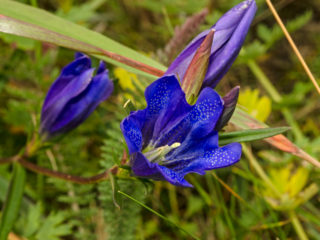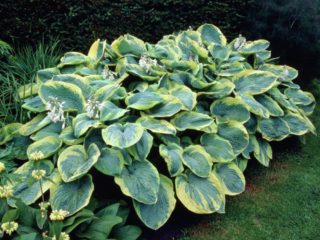Content
The gentian (Gentiana septemfida) is a herbaceous plant from the Gentian family. Distributed throughout the globe, especially often it can be seen in the highlands, in alpine and subalpine meadows. In Russia, the perennial grows in the Caucasus, in the Baltic States, in the Central regions. Prefers rocky slopes, talus, forest edges and clearings. Sometimes it is found in the depths of the forest. Due to the fragile beauty of large flowers, the gentian is very popular with flower growers. And as a healing raw material, it is widely used in the recipes of traditional healers.
Description of the species
The gentian is a perennial plant that grows in height from 10 to 50 cm. It is distinguished by a thick, fleshy rhizome with roots extending from it, in appearance resembling thin ropes. From a single root, many glossy stems grow straight or with a noticeable bend. The color is reddish brown. In the lower part of the plant, large brown scales, from the middle to the top of the stems are bright green leaves, shaped like an arrowhead or lancet. They are located in pairs. The stems are highly branched, flower buds grow at the very tops.
The flowers of the plant are large, in appearance they resemble bells. In a green calyx with serrated petals, a corolla with ovoid lobes, smoothly rounded downwards, opens. The color, depending on the variety, can be bright blue, purple, blue with white spots, sky blue. The inner part of the corolla can have a greenish, yellowish, cream, brown-red, spotted color, as well as a harmonious combination of various shades. The plant blooms from mid-summer to autumn.
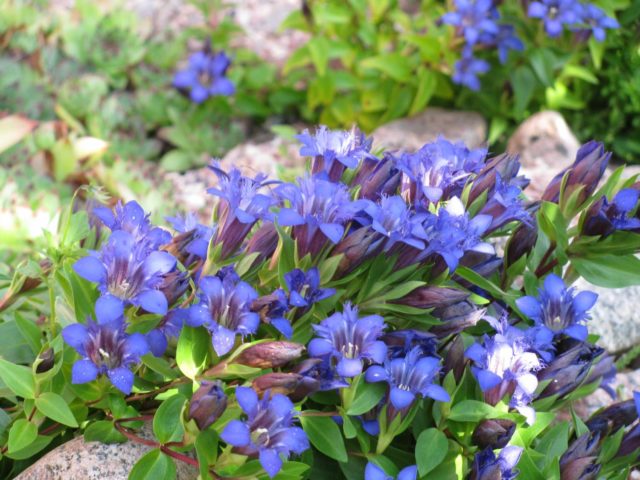
One of the features of the plant's flowers is the fringed folds between the long petals.
Popular varieties
Breeders have bred many ornamental varieties of gentian semi-divided. The most popular varieties of plants among the people serve as a worthy decoration of personal plots and magnificent components of landscape compositions.
Seven-part gentian Var Lagodekhskaya
The Lagodekhskaya seven-part gentian has dark blue bell-shaped flowers with a white throat. Petals-lobes 5, sometimes - 7. The stems of the plant lie down under their own weight, grow up to 30 cm in length, and the tops stretch up, creating a fancy green-blue carpet. Seven-part gentian Var Lagodekhiana blooms in late summer, loves sunny places and well-drained soil. Drought sensitive. The plant can withstand frosts down to -30 degrees.
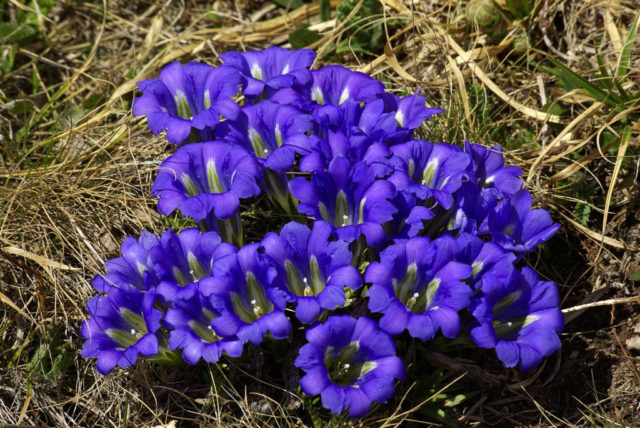
In the depths of the corollas of flowers, white-spotted elongated stripes are clearly visible
Christie's gentian
The plant variety is undersized, the length of the shoots reaches 25 cm. The stems are semi-recumbent, with ascending tops and numerous short lateral shoots. Blooms profusely from early to mid-summer. The flowers are dark blue and purple. Grows well in shaded areas, under tree crowns.It is recommended to plant on clay and stony, well fertilized and well-drained soils. Seven-part gentian "Christie" perfectly withstands frosty winters.
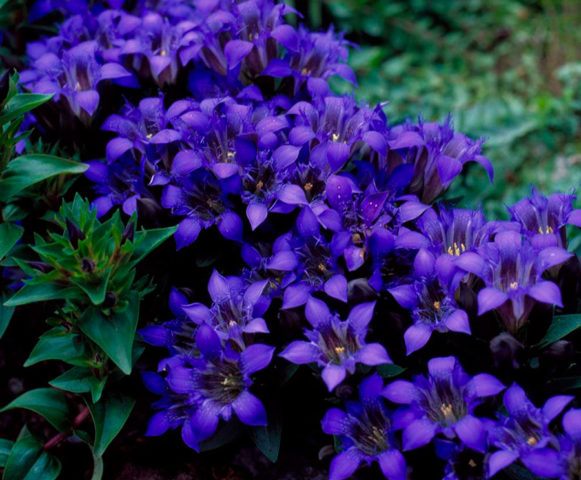
Christie's gentian is reproduced by seeds and dividing the bush
Application in landscape design
The seven-part gentian is loved by flower growers for its unpretentiousness and abundant flowering for 1.5-2 months. Its flowers are mesmerizing with their heavenly beauty. Gentian bushes resemble a luxurious green carpet on which blue or blue stars have been scattered with a generous hand.
Perennials are used to decorate curbs and rocky areas. Seven-part gentian looks perfect in the foreground with any tall plants, shrubs and dwarf conifers. Feels great under deciduous trees, parks and gardens. Seven-part gentian is also good as mono-compositions, on flower beds and retaining walls.
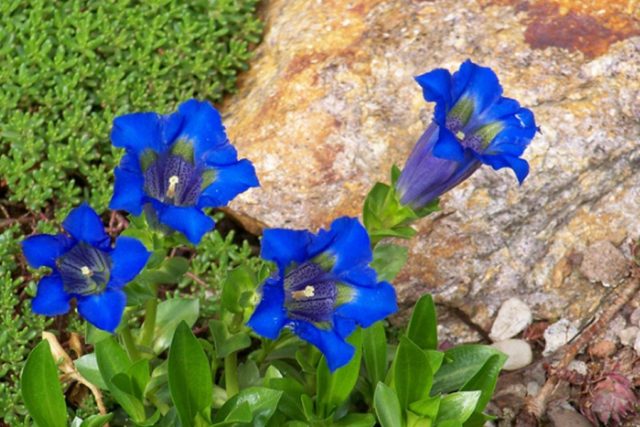
Seven-part gentian is magnificent on alpine hills, in combination with low-growing mosses, wild stone
Breeding features
Seven-part gentian reproduces in several ways:
- seeds purchased from specialized stores or harvested at the end of flowering (if not a hybrid);
- by cuttings of vegetative shoots, which must be broken off together with the heel.
Important! You should not try to propagate the plant by dividing the bush. Unlike other species, gentian septate does not tolerate damage to the root collar.
Planting and caring for a seven-part gentian
The seven-part gentian, despite its delicately sublime appearance, is completely undemanding to the conditions of detention. She loves partial shade and well-moistened, fertile soils. The plant perfectly tolerates northern winters, especially with a fairly abundant snow cover.
Landing terms and rules
It is better to plant a plant with seeds before winter, in autumn. The gentian does not impose special requirements for the composition of the soil, provided they are nutritious. Therefore, you can simply mix garden soil with well-rotted manure, compost and medium-sized stones - pebbles or gravel. The garden bed should be prepared in advance by digging it up with natural fertilizers - ash, humus, peat. On clayey soils, provide drainage from pebbles, broken bricks, at least 10 cm thick. It is recommended to add compositions of large and small stones - the gentian in nature grows on rocky slopes.
Lay out the seed material of the plant on the surface, observing a distance of 20-30 cm, sprinkle it with a layer of sand, sod earth or soil mixture, no more than 0.5-1 cm thick.Under the snow, gentian seeds winter well, and in spring they delight with friendly shoots.
If the plant did not work out in the fall, you can sprinkle the seeds in a wide, shallow bowl with moistened sand and place them in a refrigerator or any room from 2 to 5 degrees. In February, raise the temperature for two weeks to 10. Then cool again. Sow in the ground in April when the snow melts.
Treat the cuttings with "Kornevin", place them in fertile soil, cover with glass or foil. Moisten as needed. Within two weeks, the gentian should take root, after which it can be planted. It is better to reproduce in this way in April or early autumn, when the summer heat subsides, but there will be enough time for young plants to get stronger.
Watering and feeding schedule
Seven-part gentian responds well to timely watering.It is hygrophilous, ideally it is better to plant it next to streams or decorative ponds, to provide constant drip or automatic humidification. Depending on the weather conditions, you need to water it 2-3 times a week. If there is a drought, then every day. In rainy summers, additional watering is not required.
Gentian does not require additional fertilizing. When planting, bone meal or horn meal can be added to each hole. The source of essential nutrients is mulch from peat, rotted sawdust, compost, and cut grass.
Weeding and loosening
After each watering of plants, the soil surface must be loosened to a shallow depth, while choosing the roots of perennial weeds and emerging shoots. At the end, add mulch from sand or organic matter.
Preparing for winter
The gentian is a very hardy, winter-hardy culture. Both in central Russia and in Siberia, the plant hibernates without additional shelters. The exception is high beds and hills, not covered with a thick layer of snow. It is better to wrap such compositions with spruce branches, covering material or straw.
Diseases and pests
The main diseases of the gentian septate are:
- gray rot;
- rust and leaf spot;
- viral infections.
When infected with fungi, diseased parts of the plant must be urgently removed and treated with a fungicide. Viral diseases cannot be cured. Therefore, diseased bushes should be immediately dug up and burned to prevent the spread of the disease.
The pests of the seven-part gentian are:
- snails and slugs;
- aphids, ants;
- thrips, nematodes.
They fight against insect attacks by mechanical (traps and manual collection) and chemical means.
Useful properties of the plant
The seven-part gentian, in addition to its undoubted decorative merits, has the most valuable medicinal properties. Since ancient times, rhizomes and aerial parts of the plant have been used as pharmacological raw materials. They contain:
- flavonoids and alkaloids,
- phenol carboxylic acids;
- vitamin C;
- sugar, gentiobiosis and gentianosis.
Due to its chemical composition, gentian has the following effects on the human body:
- vasodilator and pressure reducing;
- sokogonny and anticoagulant;
- hemostatic and antibacterial.
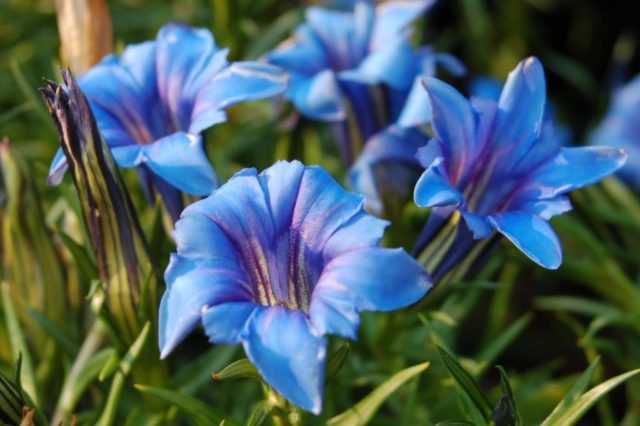
Beautiful "star" flowers are able to cure some ailments
Application in traditional medicine
In the recipes of healers from ancient times to the present day, the gentian is used to treat the following diseases:
- gastritis with decreased secretion;
- high blood pressure;
- decreased appetite, gastric and intestinal inflammation;
- malaria and plague;
- cramps, snake and insect bites;
- tuberculosis, fever, constipation and diarrhea;
- helminthic invasion;
- dysfunction of the liver and gallbladder;
- sexual dysfunctions;
- cough, scurvy, gout;
- allergic skin rash.
A decoction of gentian sevenfold is considered an excellent general tonic, especially for anemia.
Limitations and contraindications
The use of gentian seven-part has contraindications:
- pregnancy and breastfeeding;
- the appearance of an allergic reaction and intolerance to individual components in the composition of medicinal raw materials;
- a stomach or duodenal ulcer;
- gastritis in the acute stage.
Eating the plant in a wrong dosage can lead to increased blood pressure, dizziness, and nervous irritability.
Conclusion
The seven-part gentian is the star garden queen. Beautiful flowers in all shades of blue and light blue are a true decoration of the landscape. The herbaceous perennial is undemanding to care, frost-resistant and thrives on stony soils. In addition, the plant can be used as a medicine for a number of different diseases.

